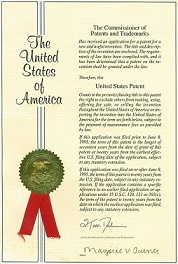US Patent No. 7864476 - Prepared by Attorney David Tran for Toshiba and filed by Schwegman (SLWK)
Brief description: FIG. 3 is a perspective view of one example of a data zone in a magnetic disk media according to an example embodiment. A soft underlayer 322 is formed on a substrate 321 with magnetic patterns constituting the recording tracks 323. The radial width and track pitch of the recording track 323 are denoted as Tw and Tp, respectively. A GMR element 331 of a read head and a single pole 332 of a write head, which are formed in the head slider, are positioned above the recording track 323. As the substrate 321, a flat glass substrate may be used. The substrate 321 is not limited to the glass substrate but an aluminum substrate (or any other suitable substrate) may be used. A magnetic material is placed onto the substrate 321 and selectively magnetized to form recording tracks. A magnetic material such as CoCrPt may be used, although example embodiments are not so limited. Although not shown, a protective film of diamond-like carbon (DLC) may be formed on the surfaces of the media. In one example, lubricant may be applied to the surface of the protective film. With reference to FIGS. 4 and 5, the patterns of the servo zones 219 and data zones 218 will be described. As schematically shown in FIG. 4, each of the servo zones 219 includes a preamble section 441, an address section 442, and a burst section 443 for detecting deviation. As shown in FIG. 5, the data zone 218 includes the recording tracks 323. Patterns of the magnetization which provide servo signals are formed in each of the preamble section 441, address section 442, and burst section 443 in the servo zones 219. These sections may have the functions described below. The preamble section 441 is provided to execute a phase lock loop (PLL) process for synthesizing a clock for a servo signal read relative to deviation caused by relative motions of the heads and media, and an AGC process for maintaining appropriate signal amplitude. The address section 442 may have servo signal recognition codes called servo-address-marks, sector data, cylinder data, and the like formed at the same pitch as that of the preamble section 441 in the circumferential direction using encoding, for example Manchester, or other types of encoding. The burst section 443 is an example of an off-track detecting region used to detect the amount of off-track with respect to the on-track state for a cylinder address. The burst section 443 includes patterns to locate a read or write head with respect to a desired track center. A pattern in FIG. 5 is shown by way of example including four fields of burst marks (A, B, C, and D), whose patterns in a radial direction are shifted relative to each other in respective fields. Other burst patterns could also be used. In one example, plural marks are arranged at the same pitch as that of the preamble section in the circumferential direction. The principle of detection of a position on the basis of the burst section 443 will not be described in detail. When using the pattern shown, the off-track amount may be obtained by calculating a function of the average amplitude value of read signals from the A, B, C, and D bursts. As discussed above, other patterns may be used that do not depend on average amplitude.
